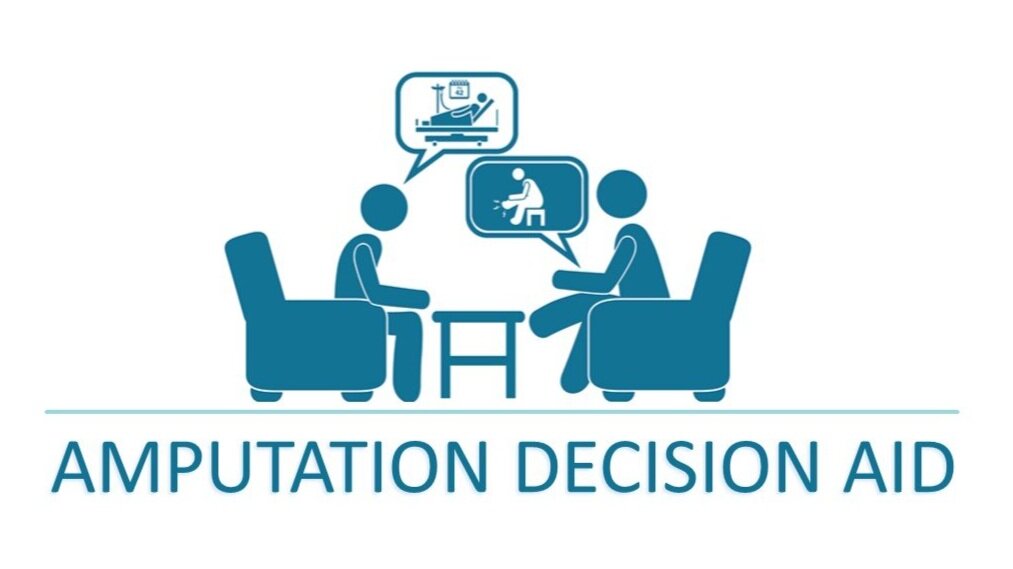Course Intended Learning Outcomes
Course description
In this course of five online modules, you will develop the skills necessary to use shared decision-making (SDM) to help people facing difficult decisions about partial foot amputation due to peripheral arterial disease, make an informed decision about their amputation.
These resources are designed for use in a clinical setting by healthcare professionals who counsel people facing lower limb amputation including: rehabilitation specialists, surgeons, high-risk foot specialists, nurse practitioners, podiatrists, prosthetists/orthotists, primary care providers.
Course Intended Learning Outcomes (CILOs)
The course intended learning outcomes are to:
1. enable clinicians to lead a SDM consultation
2. describe ways to use the Amputation Decision Aid and the Amputation Discussion Guide to facilitate a SDM consultation
Intended Learning Outcomes (ILOs)
The intended learning outcomes for each module, and their nested enabling outcomes, are described below. The intended learning outcomes sequence across modules to facilitate attainment of the course intended learning outcomes.
On completion of this course, you will be able to:
Module 1: Understand the need for SDM in clinical practice
1.1 Describe the common patient experience of the current processes surrounding dysvascular amputation surgery (e.g. feeling disempowered; feeling that the consult was not designed to facilitate participation participate; not understanding options, risks, and benefits; not connecting with clinician over values/preferences)
1.2 Describe what people wished was different about their experience of surgical decision making and how clinicians can improve the experience through patient-provider communication
Module 2: Understand what SDM is
2.1 Define SDM
2.2 Describe the process of SDM and key steps involved (e.g. encouraging patient engagement; presenting decision options and risks and benefits of each decision option; eliciting patients’ values and preferences; supporting deliberation and reflection; collaboratively making a decision that aligns with patients’ needs and preferences)
2.3 Describe the pathway to a dysvascular amputation decision, including:
2.3.1 Explaining how the process of SDM can be incorporated into the decision pathway
2.3.2 Explaining the variety of healthcare professionals that may be involved in the decision pathway
2.3.3 Explaining how SDM can be used at different points in the decision pathway and how different clinician groups may become involved
2.3.4 Explaining how SDM resources can be used at different points of the decision pathway
Module 3: Understand how to use decision aids to inform decision making
3.1 Define a decision aid (e.g. what information is commonly included in decision aids)
3.2 Describe SDM resources and their role in the SDM consultation
3.2.1 Explain what SDM resources look like (e.g. printed, online or video resources)
3.3 Explain features of a quality decision aid (e.g. developed according to IPDAS standards: using a rigorous method and meets at least minimum standards for decision aid development; evidence included reflects best peer-reviewed research; developed with input from users, including patients, clinicians and SDM experts)
3.4 Describe use of a decision aid in an initial consultation (e.g. how the resource may be used to structure the conversation during the consultation; how the resource may help present treatment options, benefits, and risks; how the resource may elicit patients’ preferences and support deliberation; how evidence in the decision aid may be incorporated into the consultation)
3.5 Describe use of a decision aid in follow-up consultations (e.g. look at patient answers in reflections section to prompt new conversations; follow up to see that understanding of the procedure and risks and benefits is accurate)
Module 4: Understand how to use discussion guides to inform decision making
4.1 Define a discussion guide
4.2 Describe how to use the discussion guide in a consultation (e.g. interpreting mortality data in a way that is appropriate for the circumstances of an individual)
4.3 Describe how to facilitate difficult conversations using SDM (e.g. while many people think about mobility issues with regard to amputation, it is not common to think about the risk of dying, despite evidence of high mortality rates)
Module 5: Understand and dispel perceived barriers to SDM
5.1 Describe evidence of the effectiveness of SDM
5.1.1 Describe evidence from systematic reviews of RCTs of SDM (e.g. increasing knowledge and risk perception accuracy, improving clinical communication and reducing decisional conflict)
5.2 Discuss common myths to implementation of SDM (e.g. consultations take too long, patients don’t want to be involved in decision making, I already do SDM)
5.3 Describe support of SDM by major organisations (e.g. NIH, CMS, legislative changes to informed consent to include SDM, use of SDM for purpose of reimbursement.)
